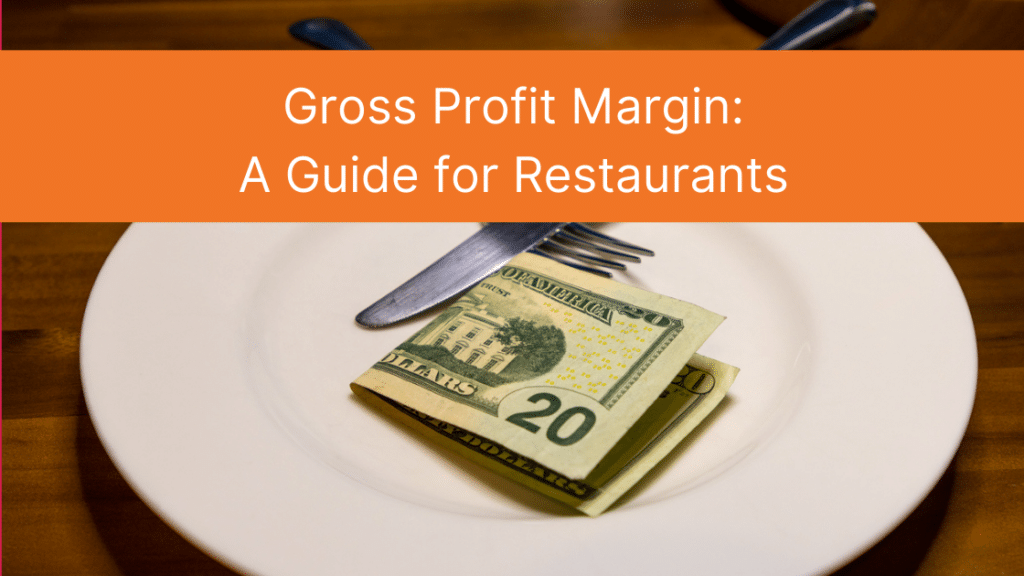In the competitive realm of the restaurant industry, understanding and optimizing your financial performance is paramount to success. While tracking total revenue and sales is vital, it’s crucial to dig deeper and delve into your restaurant’s profit margins. In this article, we explore what gross profit margin is, how to calculate it, and how it is distinguished from other profitability metrics like net and operating margins. Additionally, we will discuss the factors and insights to look for in your data, consider the common problems associated with gross profit margin, and provide practical solutions to help you keep your restaurant’s finances healthy and thriving.
Gross Profit Margin: What is it?
Gross profit margin is a fundamental financial metric that reveals the percentage of revenue left after accounting for the cost of goods sold (COGS). In the restaurant context, this encompasses the expenses associated with ingredients and other direct production costs, excluding operating costs like labor, rent, and utilities. Analyze the gross profit margin to understand how efficiently you’re managing costs and pricing your menu items.
How to Calculate Gross Profit Margin
To calculate gross profit margin, use the following formula:
gross profit margin (%) = [(Total Revenue – Cost of Goods Sold) / Total Revenue] x 100
If your revenue encompasses more than just the sale of menu items, it would also make sense to see what the margin is just for sales, rather than taking all of your revenue into account:
gross profit margin (%) = [(Total Sales – Cost of Goods Sold) / Total Sales] x 100
Gross Profit vs. Net Profit vs. Operating Profit
Three of the most critical metrics to understand and track are Gross Profit, Net Profit, and Operating Profit. Each plays a distinct role in assessing a restaurant’s financial health. These metrics go beyond merely counting revenue and expenses; they reveal the core profitability of the business, while accounting for various financial components. By comprehending the distinctions between these metrics, restaurant professionals can make informed decisions, identify areas for improvement, and maintain a robust financial foundation in the ever-competitive restaurant industry.
Gross Profit
Gross profit margin is a fundamental financial metric in the restaurant industry. Gross profit represents the difference between the total revenue or sales a restaurant generates and the cost of goods sold (COGS). Gross profit is a critical indicator of the core profitability of a restaurant’s menu items, reflecting how efficiently it manages costs and pricing. By maintaining a healthy gross profit margin, restaurants can ensure that they have a strong foundation for covering operating expenses, investing in growth, and ultimately achieving long-term financial success.
Operating Profit
Operating profit, often referred to as operating income or operating margin, is a critical financial metric that extends the concept of gross profit margin by factoring in all operating expenses. Gross profit margin measures the profitability of a restaurant’s core menu items after the cost of goods sold is considered, but operating profit goes further by accounting for costs like labor, rent, utilities, marketing, and other overhead expenses.
A healthy gross profit margin, while important, doesn’t guarantee a strong financial position unless operating expenses are well managed. Operating profit reflects the efficiency and effectiveness of a restaurant’s day-to-day operations, providing a clear indicator of how well the restaurant is covering its ongoing expenses and generating a sustainable income. By optimizing both gross profit margin and controlling operating expenses, restaurants can bolster their operating profit, and ensure long-term financial success and viability.
Net Profit
While gross profit margin measures a restaurant’s profitability before accounting for operating expenses, and operating profit then also accounts for operational costs, net profit provides a comprehensive picture of the restaurant’s financial health. Net profit considers all costs, including not only the cost of goods sold and operating expenses, but also interest, taxes, and any other financial obligations. It’s the bottom line, representing the actual profit the restaurant has earned after all expenses are deducted.
A high gross profit margin is valuable, but it’s the net profit that truly signifies a restaurant’s success, as it reflects the overall profitability and sustainability of the business. By managing gross profit margin effectively and controlling operating expenses, restaurants can maximize their net profit, ensuring financial stability and future growth.
Find more information to Understanding a Restaurant Profit and Loss Statement.
What to Look for in Gross Profit Margin Data
To navigate the complex restaurant terrain effectively, restaurant owners and managers must closely scrutinize their gross profit margin data. Through exploring aspects of gross profit margin data, we will offer insights and strategies that will empower restaurants to bolster profitability, stay ahead of trends, and maintain a strong competitive edge in the restaurant industry.
Margin Percentage
When analyzing gross profit margin data in the restaurant business, one of the most critical aspects to examine is the margin percentage. This percentage offers a direct measure of how efficiently a restaurant is converting its sales into profit, making it an essential gauge of financial health. A higher margin percentage indicates that a larger portion of sales is retained as gross profit, implying a more effective management of cost of goods sold and menu pricing.
It’s vital to monitor trends in the margin percentage over time, as increases could indicate improved cost control and pricing strategies, while declines may necessitate adjustments. Additionally, comparing the margin percentage to industry benchmarks can provide insights into a restaurant’s competitive position. By focusing on this key component of gross profit margin data, restaurant owners and managers can better understand their financial performance, make informed decisions, and work toward optimizing profitability in a highly competitive industry.
Trends
Identifying trends is of paramount importance when delving into gross profit margin data for restaurants. Tracking trends over time can reveal shifts in the profitability of a restaurant’s core operations. Increasing gross profit margins might indicate cost control improvements, menu optimization, inventory and supplier management, or effective pricing strategies. Conversely, decreasing trends might signify escalating ingredient costs or inefficiencies in the supply chain.
By paying close attention to these trends, restaurant owners and managers can proactively address challenges and capitalize on opportunities, ultimately ensuring the sustainability and profitability of their business. Analyzing gross profit margin trends is a powerful tool for making data-driven decisions and adapting to the ever-evolving landscape of the restaurant industry.
Examine how your gross profit margin changes over time and analyze trends over different time periods (daily, weekly, monthly) to identify patterns or fluctuations.
Comparison to Industry Benchmarks
Comparing a restaurant’s gross profit margin to industry benchmarks is a critical aspect of financial analysis. Benchmarking allows restaurant owners and managers to assess their performance relative to their competitors and industry standards. If a restaurant’s gross profit margin falls significantly below industry averages, it could indicate inefficiencies in managing costs, pricing, or menu composition. Conversely, surpassing industry benchmarks suggests that a restaurant is excelling in profitability.
These comparisons offer valuable insights into a restaurant’s competitiveness and can serve as a basis for setting goals and improving financial strategies. By gauging their gross profit margin against industry benchmarks, restaurants can identify areas for enhancement, fine-tune their operations, and work toward achieving a more competitive and profitable position in the market.
Menu Item Contribution
When exploring gross profit margin data for restaurants, examining the contribution of individual menu items is a key element. It allows restaurant owners and managers to identify which menu items are the primary drivers of profitability.
By assessing the contribution of specific dishes, beverages, or specials, restaurants can make informed decisions about their menu offerings. High-margin items that perform well can be emphasized, and less profitable items can be reevaluated or replaced. This approach can optimize menu composition to enhance overall profitability and customer satisfaction.
Additionally, analyzing the contribution of menu items can reveal which items have the potential to become signature dishes or featured specialties, drawing in more customers and boosting revenue.
Ultimately, paying attention to menu item contribution within the context of gross profit margin data enables restaurants to fine-tune their offerings for maximum profitability and customer appeal.
Common Gross Profit Margin Problems and Solutions
Gross profit margin stands as a pivotal financial metric, serving as a barometer of a restaurant’s profitability. However, restaurant owners and managers often grapple with common issues that can adversely affect this crucial metric. We will explore these common gross profit margin problems and provide actionable solutions, equipping restaurant professionals with the knowledge and strategies needed to navigate these challenges effectively.
Declining Margin percentage
One of the common challenges that restaurants face within the realm of gross profit margin is a declining margin percentage. When a restaurant’s margin percentage consistently drops, it can signal a pressing need for action. When your gross profit margin is consistently decreasing, it’s essential to pinpoint the causes. Here are some options for solutions:
Menu Analysis
Review the menu and carefully examine each menu item’s contribution to the overall margin percentage to identify items with low contribution margins. Items with declining profitability may need to be reformulated or removed, while high-margin dishes can be promoted and upsold.
Consider adjusting prices, portion sizes, or ingredients to improve profitability. By revamping the menu to include higher-margin items and eliminating underperforming options, restaurants can effectively address the problem of a declining margin percentage and boost their overall profitability.
Cost Control
A common issue that restaurants encounter when there is a declining margin percentage is a difficulty in cost control. To address this problem, restaurants must implement cost control measures that span across ingredient procurement, portion sizes, and kitchen operations.
Evaluating supplier relationships and negotiating for better prices can significantly impact the cost of goods sold, helping to maintain a healthy margin percentage. Efficient portion control and recipe standardization can reduce waste and control expenses. Menu price adjustments that align with changing ingredient costs are essential to safeguarding profitability.
By addressing the issue of a declining margin percentage through rigorous cost control strategies, restaurants can ensure the sustainability of their financial health and, ultimately, their long-term success.
Stagnant Margin Percentage
Stagnant margin percentage is a common challenge in the restaurant industry that can stagnate overall profitability. When a restaurant’s margin percentage remains constant over an extended period, it may suggest a lack of innovation and adaptability. To address this issue, restaurants can employ various strategies. Here are some options for solutions:
Regular Menu Refresh
Regular menu updates, including the introduction of innovative and high-margin items, can rekindle customer interest and spending. Keep the menu fresh and appealing by introducing new items, seasonal specials, or limited-time offers to encourage repeat visits. Innovate your menu with higher-margin items or premium ingredients.
Pricing Strategy
Periodically adjust menu prices to reflect changes in ingredient costs and maintain profitability. Dynamic pricing strategies during peak hours or for popular dishes can boost revenue. Monitor market trends and adjust your offerings accordingly and continuously assess your operations for cost-saving measures.
Upselling
Train staff to consistently suggest higher-margin items, special dishes, or add-ons to boost revenue. By encouraging customers to explore premium menu offerings, restaurants not only enhance profitability but also elevate the dining experience. Monitoring and incentivizing upselling performance among the team can help ensure that this solution becomes a routine practice.
Low Margin Percentage Relative to Industry Benchmarks
A common challenge in the restaurant industry is a margin percentage that falls below industry benchmarks. This issue can seriously impact a restaurant’s financial performance and competitiveness. Embracing the following solutions ensures that a restaurant’s financial health remains robust and competitive in the broader restaurant landscape.
Competitor Analysis
A thorough competitor analysis is essential in identifying the strengths and weaknesses of rivals and opportunities to differentiate the restaurant. Analyze the pricing, menu offerings, and cost management strategies of competitors to identify areas where your restaurant can improve.
Value-Added Services
Offering value-added services, such as exclusive promotions, loyalty programs, or special events, can enhance the overall customer experience, potentially justifying higher pricing and bolstering the margin percentage. Consider offering unique or value-added services that justify slightly higher prices, such as complimentary items or exceptional customer service. Rethink your menu composition to include high-margin items.
Supplier Relationships
Scrutinize your supplier relationships and search for more cost-effective options. Nurturing strong supplier relationships to negotiate better pricing on quality ingredients is vital to control costs.
Enhance Productivity
To improve overall productivity and efficiency, restaurants should focus on optimizing kitchen operations, staff training, and portion control. Streamline your operational processes to enhance efficiency.
Inefficient Menu Item Profitability
Inefficient menu item profitability is a persistent issue in the restaurant business that can significantly impact the gross profit margin. By fine-tuning menu offerings, improving supplier relationships, and ingredient costs, restaurants can overcome the problem of inefficient menu item profitability and achieve higher overall profitability and customer satisfaction. Here are some options for solutions:
Menu Engineering
Identify underperforming menu items and make data-driven decisions about whether to improve, replace, or remove them. Underperforming menu items can be either revamped, re-priced, or removed entirely. Promote high-margin items through marketing and menu placement. Consider ingredient substitutions to reduce costs while maintaining quality.
Supplier Relationships
Restaurants can work closely with their suppliers to negotiate better prices and secure high-quality ingredients. By optimizing supplier relationships, restaurants can reduce ingredient costs while maintaining the quality of their menu items. Furthermore, working collaboratively with suppliers allows restaurants to source seasonal or local ingredients at competitive prices, enhancing the profitability of their dishes.
Ingredient Cost Variability
Restaurants grappling with inefficient menu item profitability often find that ingredient cost variability is a major culprit. Ingredient prices can fluctuate due to various factors, impacting the gross profit margin.
Supplier Contracts
Establish long-term contracts with suppliers to stabilize ingredient costs and reduce fluctuations. Or consider alternative suppliers or negotiate fixed-price contracts with their current suppliers to stabilize ingredient costs.
Menu Consistency
Ensure that menu items and recipes are consistent to minimize variations in ingredient usage and cost. Adopt smart inventory management practices and strategic menu engineering can help reduce waste and control costs.
Rising Ingredient Costs
The challenge of inefficient menu item profitability, exacerbated by rising ingredient costs, is a common hurdle in the restaurant industry. Unexpected spikes in ingredient costs can squeeze your margins. To address this issue, restaurants should actively manage their ingredient procurement.
Menu Adjustments
Adjust menu prices to reflect rising costs, but be mindful of customer perception and competition. Explore ingredient alternatives or menu adaptations to counter cost increases. Embracing menu engineering practices to prioritize high-margin items and smart portion control techniques can enhance efficiency and reduce waste.
Supplier Negotiation
Exploring alternative suppliers or negotiating long-term contracts to secure stable pricing can help mitigate the impact of fluctuating ingredient costs.
Menu Diversification
Consider adding more high-margin items to the menu to offset increased costs. When selecting ingredients, a focus on seasonality and local sourcing can also contribute to cost stability and freshness.
Gross profit margin is a pivotal financial metric for restaurant owners and managers. By diligently tracking this metric, and implementing strategic solutions to address common problems, you can ensure that your restaurant remains profitable and competitive in a dynamic industry. Remember that staying adaptable and continuously monitoring your financial performance is key to long-term success in the restaurant business.
Stay on Top of Your Restaurant Analytics with SynergySuite
Being able to readily stay on top of your data, and make informed decisions based on that data, it’s absolutely critical to have implemented a quality restaurant reporting and analytics platform like SynergySuite.
Many of the problems and challenges of running a restaurant can be solved or avoided with the right restaurant reporting tools. We offer restaurant analytics software that captures and presents your data in an easy-to-understand dashboard. We make it simple to use your valuable data to save time, improve profitability, and ensure compliance with regulations.
Schedule a demo today to see how SynergySuite can help you take your restaurant business to the next level.





